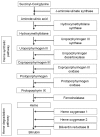Differences in the sensitivity of ovarian cancer to photodynamic therapy and the mechanisms for those differences
- PMID: 28588733
- PMCID: PMC5452891
- DOI: 10.3892/ol.2017.6095
Differences in the sensitivity of ovarian cancer to photodynamic therapy and the mechanisms for those differences
Abstract
Protoporphyrin IX (PpIX) levels are crucial to the antitumor action of photodynamic therapy (PDT). In the present study, the underling molecular mechanisms for the variation in PpIX levels in ovarian cancer cells were investigated. Five ovarian cancer cell lines were subcutaneously grafted onto the backs of nude mice. Once tumors had developed, 5-aminolevulinic acid methyl ester hydrochloride (methyl-ALA) was administered intraperitoneally and the tumor was irradiated twice/week. PpIX levels in the tumor were assayed using high-performance liquid chromatography. Enzymes involved in heme synthesis and degradation were screened using a microarray technique. Expression of the glutathione transferase Omega-1 (GSTO1) gene involved in the conversion of PpIX into heme in cells was quantified using the reverse transcription-quantitative polymerase chain reaction. In HTOA, HRA and DISS cells, PDT resulted in significant tumor shrinkage in comparison with the controls. In MCAS and TOV21G cells, no significant alterations in tumor growth were identified compared with the untreated cells. PpIX levels increased significantly in HTOA, DISS and HRA cells compared with in MCAS and TOV21G cells. A comparison of genetic profiles using PDT-sensitive DISS cells and PDT-resistant MCAS cells indicated that MCAS cells exhibited significantly increased levels of δ-aminolevulinate synthase (a rate-limiting enzyme in heme synthesis), heme oxygenase 2 (an enzyme that degrades heme into biliverdin), and biliverdin reductase B (an enzyme that reduces biliverdin into bilirubin) in comparison with DISS cells. The level of GSTO1 expression in HTOA, HRA and DISS cells was ~2.5-fold that in MCAS and TOV21G cells. Sensitivity to PDT is related to PpIX levels in cells. The results of the present study suggested that PpIX tends not to accumulate in PDT-resistant cells despite active heme synthesis and degradation, and that high levels of GSTO1 expression are associated with increased sensitivity to PDT.
Keywords: 5-aminolevulinic acid methyl ester hydrochloride; glutathione transferase Omega-1; ovarian cancer; photodynamic therapy; protoporphyrin IX.
Figures



Similar articles
-
Effects of Silencing Heme Biosynthesis Enzymes on 5-Aminolevulinic Acid-mediated Protoporphyrin IX Fluorescence and Photodynamic Therapy.Photochem Photobiol. 2015 Jul-Aug;91(4):923-30. doi: 10.1111/php.12454. Epub 2015 Apr 8. Photochem Photobiol. 2015. PMID: 25809721
-
Accumulation of protoporphyrin IX in medulloblastoma cell lines and sensitivity to subsequent photodynamic treatment.J Photochem Photobiol B. 2018 Dec;189:298-305. doi: 10.1016/j.jphotobiol.2018.11.002. Epub 2018 Nov 7. J Photochem Photobiol B. 2018. PMID: 30445362
-
Novel potential photodynamic therapy strategy using 5-Aminolevulinic acid for ovarian clear-cell carcinoma.Photodiagnosis Photodyn Ther. 2018 Mar;21:121-127. doi: 10.1016/j.pdpdt.2017.11.013. Epub 2017 Nov 28. Photodiagnosis Photodyn Ther. 2018. PMID: 29196245
-
Aminolevulinic Acid-Based Tumor Detection and Therapy: Molecular Mechanisms and Strategies for Enhancement.Int J Mol Sci. 2015 Oct 28;16(10):25865-80. doi: 10.3390/ijms161025865. Int J Mol Sci. 2015. PMID: 26516850 Free PMC article. Review.
-
5-Aminolevulinic acid regulates the inflammatory response and alloimmune reaction.Int Immunopharmacol. 2016 Aug;37:71-78. doi: 10.1016/j.intimp.2015.11.034. Epub 2015 Nov 28. Int Immunopharmacol. 2016. PMID: 26643355 Review.
Cited by
-
Photochemical Targeting of Mitochondria to Overcome Chemoresistance in Ovarian Cancer †.Photochem Photobiol. 2023 Mar;99(2):448-468. doi: 10.1111/php.13723. Epub 2022 Oct 19. Photochem Photobiol. 2023. PMID: 36117466 Free PMC article. Review.
-
Which cell death modality wins the contest for photodynamic therapy of cancer?Cell Death Dis. 2022 May 13;13(5):455. doi: 10.1038/s41419-022-04851-4. Cell Death Dis. 2022. PMID: 35562364 Free PMC article. Review.
-
Systematic Review and Meta-Analysis of In Vitro Anti-Human Cancer Experiments Investigating the Use of 5-Aminolevulinic Acid (5-ALA) for Photodynamic Therapy.Pharmaceuticals (Basel). 2021 Mar 7;14(3):229. doi: 10.3390/ph14030229. Pharmaceuticals (Basel). 2021. PMID: 33800109 Free PMC article. Review.
-
Mechanism of Differential Susceptibility of Two (Canine Lung Adenocarcinoma) Cell Lines to 5-Aminolevulinic Acid-Mediated Photodynamic Therapy.Cancers (Basel). 2021 Aug 19;13(16):4174. doi: 10.3390/cancers13164174. Cancers (Basel). 2021. PMID: 34439326 Free PMC article.
-
Photodynamic Therapy Using a New Folate Receptor-Targeted Photosensitizer on Peritoneal Ovarian Cancer Cells Induces the Release of Extracellular Vesicles with Immunoactivating Properties.J Clin Med. 2020 Apr 21;9(4):1185. doi: 10.3390/jcm9041185. J Clin Med. 2020. PMID: 32326210 Free PMC article.
References
-
- Hofstetter G, Concin N, Braicu I, Chekerov R, Sehouli J, Cadron I, van Gorp T, Trillsch F, Mahner S, Ulmer H, et al. The time interval from surgery to start of chemotherapy significantly impacts prognosis in patients with advanced serous ovarian carcinoma-analysis of patient data in the prospective OVCAD study. Gynecol Oncol. 2013;131:15–20. doi: 10.1016/j.ygyno.2013.07.086. - DOI - PubMed
-
- Akeson M, Zetterqvist BM, Dahllöf K, Brännström M, Horvath G. Effect of adjuvant paclitaxel and carboplatin for advanced stage epithelial ovarian cancer: A population-based cohort study of all patients in western Sweden with long-term follow-up. Acta Obstet Gynecol Scand. 2008;87:1343–1352. doi: 10.1080/00016340802495491. - DOI - PubMed
LinkOut - more resources
Full Text Sources
Other Literature Sources
Research Materials
Miscellaneous
